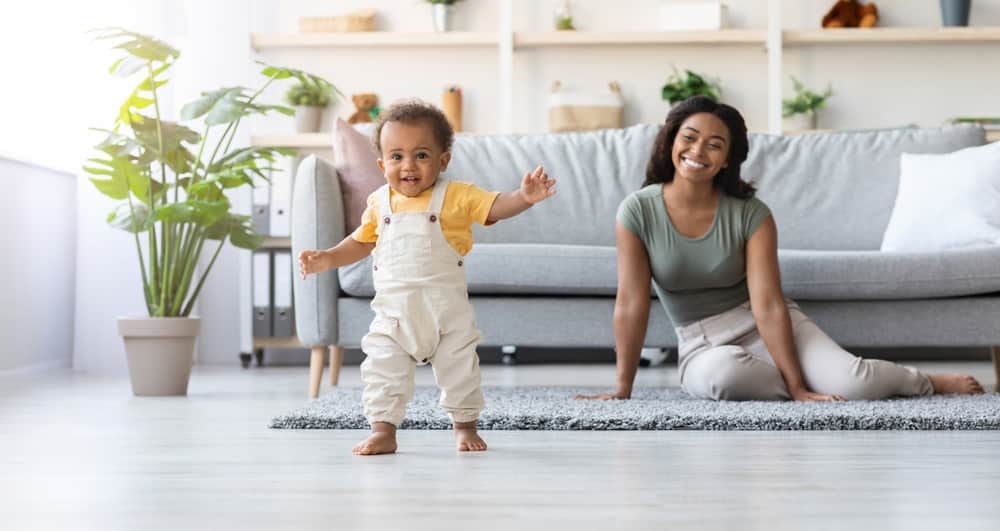It's amazing to see your baby grow into a toddler and eventually start talking, but you might be wondering: When do babies start walking? Ideally, babies start walking between 8 and 16 months. Another answer is that babies do this when they are ready. You already know that every baby is different and that they learn new skills at different times.
Let's talk more about your baby learning to walk, as well as when you might want to consult a doctor.
Key Points
- While most babies begin walking by 16 months, it could take some as long as a year and a half to begin walking.
- Your baby will initially begin holding on to furniture and similar objects while they try to learn how to walk.
- Over the first couple years that they're walking, you'll notice your toddler gradually get better and better!
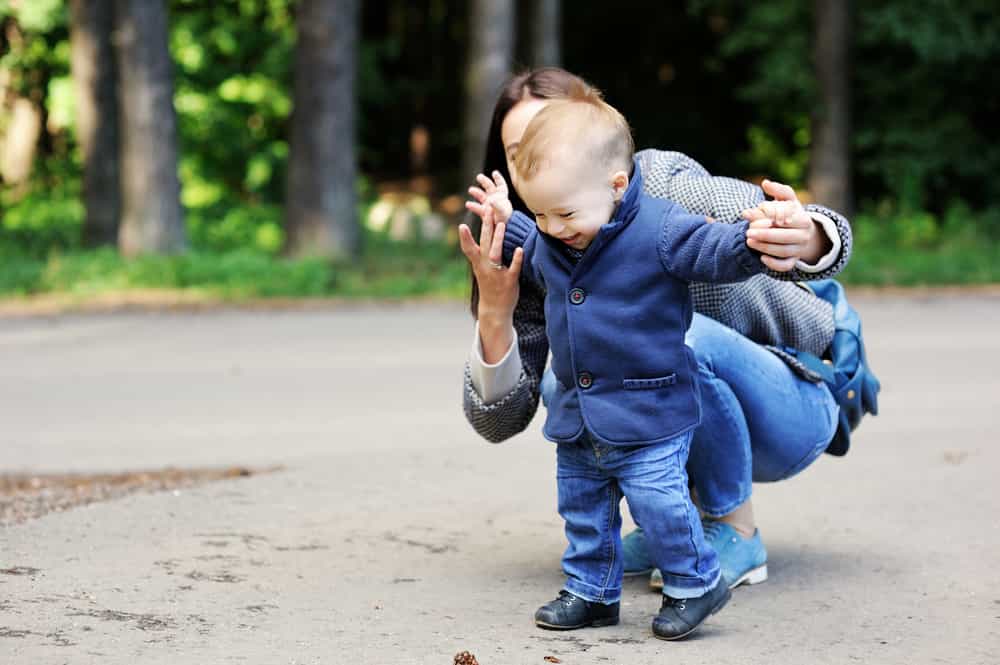
At age 8-16 months, Baby is ready to take on the world!
©Alinute Silzeviciute/Shutterstock.com
When Should a Baby Start Walking?
When it comes to walking, the average range of development is very wide: While some babies are walking around the room well before their first birthday, others aren't ready for their first step until they are nearing 18 months. Part of that timing depends on your child's own skills. Some of us are better at keeping our balance than others. But it also has to do with your baby's personality, which can be cautious and thoughtful or thrill-seeking and daring. For instance, one baby might be happy to crawl around the room for weeks, while another might be ready to walk without help after just a few days of practice. Their first steps will be awkward, so watch out for them!
What are Some Signs That They'll Soon Be Walking?
If you want to know if your baby is getting ready to walk, look for these signs:
- Cruising: Once your baby knows how to get up and down, for balance, they will usually take a few steps as they hold on to furniture. Your baby's coordination, muscle strength, and balance will improve at the cruising stage. He or she will also practice walking with the help of a stable object. As your baby keeps practicing cruising, his or her confidence in walking will grow. Sometimes, your baby will stand for a few seconds before falling back down.
- Standing: When babies can stand up on their own without holding on to something, they will start to hold their arms out in front of them for balance. Over and over, they will practice standing up and sitting down. When you see this, you can be sure that your baby will soon be able to walk.
- Pulling Up: Many babies show that they are ready to walk by pulling themselves up to stand. Most of the time, this happens after your baby has learned how to sit up. Your baby will use a stable object like a chair, the sides of a playpen, a table, or even your leg to help them stand up from sitting.
How Does Walking Develop?
Indeed, walking is the reward for a busy year of learning new skills. During their first year, your baby's body went through a lot of changes, like cruising, standing, crawling, sitting, rolling, and controlling their head.
These changes helped them get ready to walk by:
- Setting up the cognitive skill of motor planning, which will help them do things like step around or over toys that are in their way.
- Getting better at seeing so they can focus both close up and far away.
- Their bones and muscles got stronger.
- Building up their senses so they can find and keep their balance, know where their body parts are in relation to each other, and how to use them to move in a coordinated way.
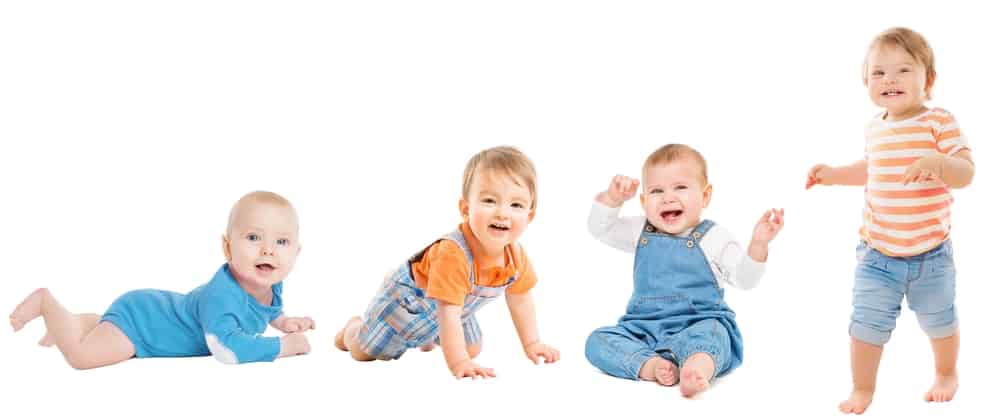
Baby has undergone so many changes in the past 12 months.
©Inara Prusakova/Shutterstock.com
Development of Small and Large Motor Skills and Walking
The first three years of a baby's life are a time when they get better at what they already know. As a child learns to move around their environment with ease, their gross motor skills get better.
At first, your baby's first steps will be stiff and awkward. Her legs will be bent, and she'll walk with stiff arms and outstretched legs, making her look a little like Frankenstein! By the time she is about 3 years old, her legs will be straight, with more graceful, controlled steps, and she will know that her heel touches the floor first and her toes push the foot off.
Your baby's fine-motor foot skills will improve as she learns to step over things, turn, shift her weight, and keep her balance. This will prepare her for future milestones like climbing, running, and jumping.
How to Get a Baby to Stand Up and Walk for the First Time
A big step in your baby's life is when they pull themselves up to stand and then take the next step to walk. It requires your baby to use almost all of their major muscle groups simultaneously, from their arms and back to their legs and feet. Standing is the first step to taking those all-important baby steps. It is a great way to strengthen their muscles.
When to Expect Baby to Stand
Most babies start pulling themselves up to stand between 9 and 12 months of age. They'll use anything they can hold on to, like the couch, a chair, or your jean-covered leg, to help them do this. But, like all major points in time, this window could change.
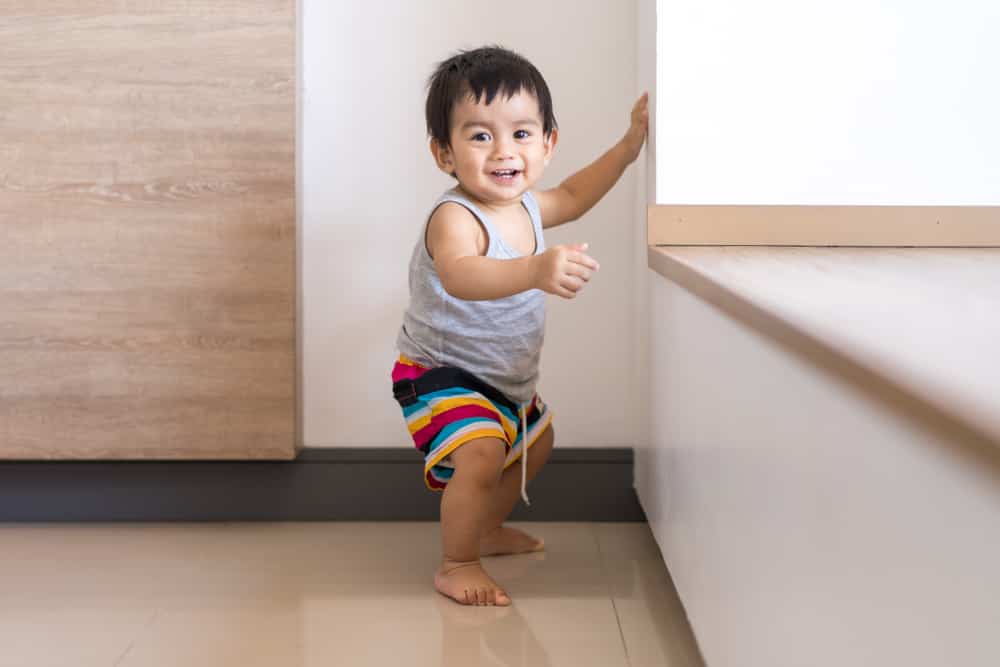
Plenty of careful cruising sets the stage for walking soon enough.
©SUKJAI PHOTO/Shutterstock.com
Some babies don't learn to stand up until much later, and they may need some gentle help. Try not to worry about your child not standing up right away. Instead, give them lots of fun, safe, and encouraging ways to practice. They'll get it in the end, and then there's no stopping them!
Encouraging Standing and Walking
For your baby to stand, let alone walk, their legs, hips, and core muscles need to be strong enough. This strength will come from crawling, sitting and rolling, so try to get your baby to do these things as much as possible:
Give the Right Kind of Help
If you are a parent who puts their hands out to help their child stand up, you are not alone. Most parents think that this is a good way to help a child stand up. The bad news is that it actually makes your baby lean forward. If you try to walk with them, you'll see that they move quickly. This is because they are out of balance and trying to get back to where they should be. Instead of reaching out with your hands, put your support on their trunk. This will keep their feet flat on the ground instead of tilted, which will strengthen their muscles and bones.
Get Going Early
Most babies can start to stand on their own legs when they are held upright between 4 and 5 months. A majority will bounce a little with their knees bent. This activity helps your baby get used to standing by themselves and can help them start to build muscle in their hips and legs.
Encourage Them to Be Barefoot
Most pediatric therapists will tell you to keep your baby's feet bare as much as possible. Babies use their sense of touch to find their way, and by feeling the ground, they can adjust their balance when they are standing. When your baby can't feel through their shoes, they can't learn how to use their joints, muscles, and posture in different ways for different surfaces.
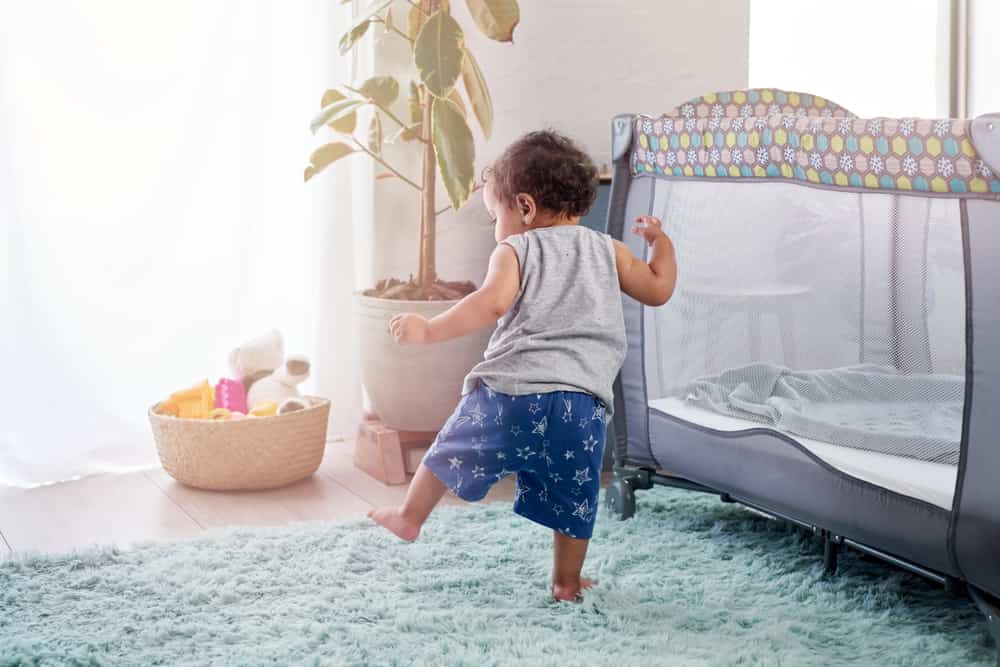
Exposing babies to different surfaces strengthens the muscles they need to balance themselves and walk appropriately.
©Daxiao Productions/Shutterstock.com
Encourage Cruising
Once your baby knows how to pull themselves up to stand, they will start to cruise along furniture. You can get them to do this by putting toys just out of their reach. Long cruises improve your baby's ability to stand for long periods of time and strengthen their thigh and hip muscles. Over time, they will be more stable when they are standing on one foot and better at moving their weight from one foot to the other.
Encourage Squatting
Squatting is a very important skill that will help your baby a lot when they start to stand on their own. When they are sitting on a couch, put toys at their feet and tell them to squat down and pick them up. By going up and down, your thighs and hips will get stronger.
Keep Movable Objects Away
If your chairs are light and easy to knock over, move them away from your baby and replace them with things they can pull up on that are sturdy and won't move. If they pull themselves up and then pull a chair down on top of themselves, it might scare them and keep them from trying again.
Keep Toys on Tables and Chairs That Baby Can Reach
If you pick up your baby's toys from the ground and put them on a surface they can reach, they will be more likely to move up and down. If they are having trouble pulling themselves up, put your hands on their hips or put a hand under their bottom to help.
Cheer Them On
Encouragement is the best way to get a baby or an adult to do something. Everyone likes to clap and cheer, so use this to get more people to stand up. Encourage them in a big way so they really get the point that standing is great.
Encourage Exploring
Floor time is important for development, and the more time you give your baby to freely explore their world, the more likely it is that they will figure out height on their own. Also, let her try walking on different surfaces. Balance and coordination can also be improved by learning how to walk on mud, sand, grass, hard floors, and so on.
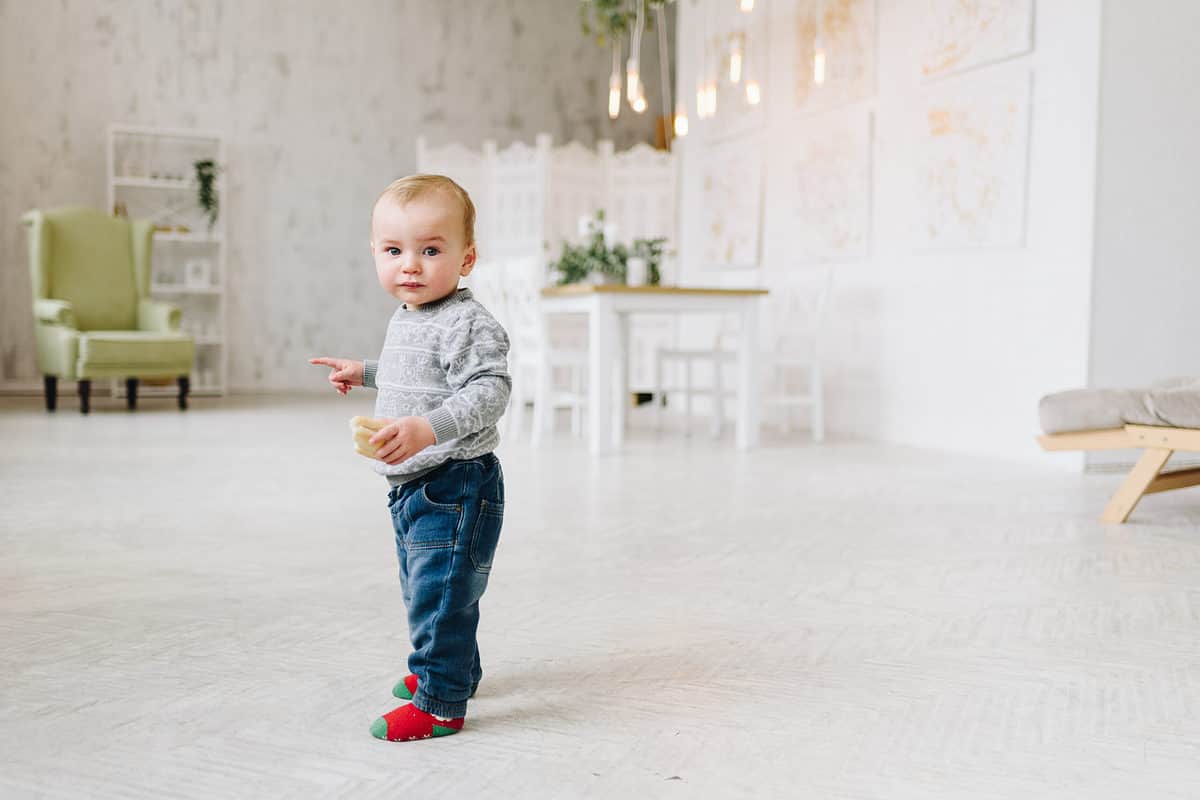
Baby needs lots of walking practice to get it right eventually.
©Anastasiia Chepinska/Shutterstock.com
Move to a Beat
Babies love to move in time to music, so put on some tunes and let them dance. Music makes bouncing a lot of fun and builds strong leg muscles and a strong core. Use their energy to your advantage and dance together as much as you can!
Play With Others
Allowing babies to watch others is the best way for them to learn because they are influenced so easily. Set up a lot of play dates with other toddlers and babies, and soon they'll be trying to keep up. If your baby sees other babies pulling up to stand, they might do it too.
Make Everything Childproof
The same idea of safety goes for ledges or corners that can hurt your baby if she bumped into them. Be sure to protect your baby's sensitive head by padding places where it could hurt if it bumped into something. Pick up any toys, magazines, or papers that could cause someone to trip or fall. If your baby needs to wear socks to keep his or her feet warm, choose socks that won't slip.
Spend Less Time Carrying Your Baby
We know you love holding and cuddling baby, but if you hold baby too much, it can delay a child's ability to walk. If Baby never gets the chance to move more on his own, he won't be motivated to do so. When teaching a baby to walk, give them plenty of time each day to explore and improve their skills on their own. This will make them more interested in reaching the walking milestone.
Be Patient!
Remember that the first steps can happen at any age. Follow her lead and help her walk when she's ready, unless you think there's something wrong with how she's growing up. Remember that babies develop at their own pace and will most likely surprise you with their first step when you're not looking!
Do Walkers Help Babies Walk?
Even though they are called “baby walkers,” they are not good for helping your baby learn to walk. Because of how they hold your baby, baby walkers can stop healthy leg muscles from growing and make your child more likely to get hurt.
Instead, stationary activity centers or push-and-pull toys can help your baby build leg strength and confidence as he or she learns to walk.
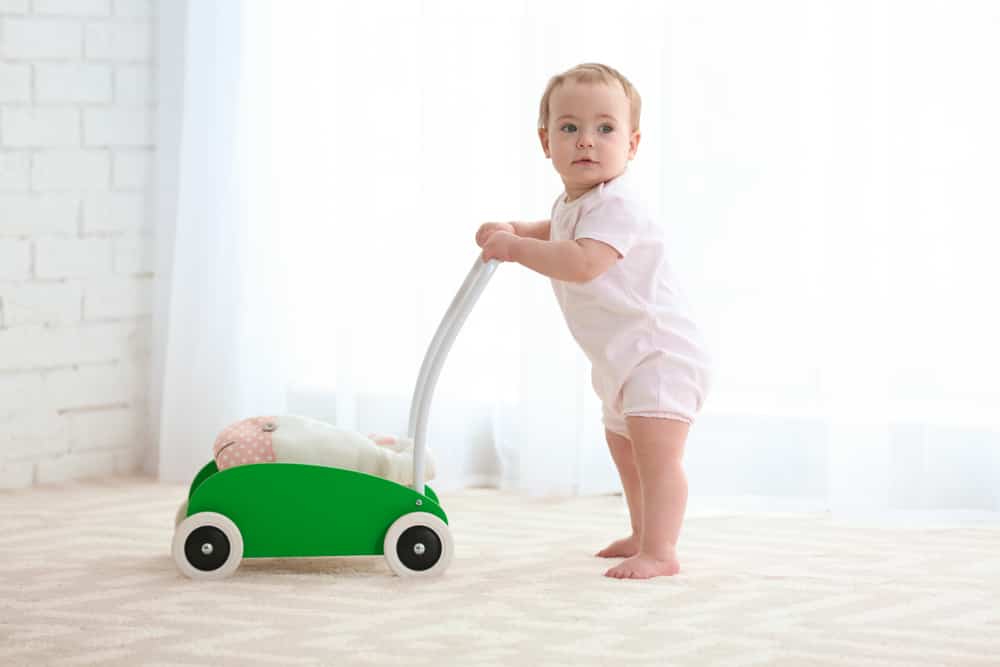
Push-and-pull toys are better alternatives than walkers.
©New Africa/Shutterstock.com
How Long Do Babies Need to Be in a Walker?
As we've already said, getting a walking aid for a baby probably won't help them learn to walk.
But if you really want your baby to use a walking aid, they should only use it for 20 minutes at a time.
When Can a Baby Start Using a Walker?
Well, they're not meant for babies just learning to walk, so the best time to use a baby walker is between 4 and 10 months.
When to See a Doctor
No matter what their parents do, most kids start walking between their first birthday and around 16 months. But talk to a pediatrician about your worries if your child is still not interested in walking at 15 or 16 months, especially if they were late on other milestones.
If any of the following things happen to your child, you should call a doctor:
- Doesn't do anything on their own by 15 months
- 18 months old and still can't walk on their own
- Unsteady when walking at two years
- Has an unusual gait at three years
- Suddenly stops walking
A delay in walking can sometimes be a sign of a developmental delay that needs to be treated, or it could be a sign of another health problem. Most of the time, though, all is well, and your toddler may start walking at any moment, even if they weren't trying a week or so ago.
What Milestone Comes After Walking?
For many parents, learning to walk is one of the most significant milestones their baby can achieve. But, your child is not done once they complete this important step! Once your baby masters walking, you can expect them to begin learning how to do other things with their legs! First, you'll typically see them begin to run and jump. As they near and surpass three years, stair climbing, ball catching, and tricycle riding will become possible!
As always, if your child is not nearing these milestones within a reasonable amount of time, consult their pediatrician. You should also reach out to their doctor if you notice your child is attempting to reach these milestones, but is struggling significantly.
Conclusion
Most parents can't wait for their child to take their first steps, and it's so fun to see your baby learn to walk. But try not to worry too much about when it will happen and try to be patient. Instead, enjoy the big moment when it comes, and be ready with a video camera, a kiss, a bag of frozen vegetables, or a popsicle for the bumps and bruises that come with first steps. If your child is 15 months old and hasn't taken a step, talk to a doctor or nurse.
The image featured at the top of this post is ©Prostock-studio/Shutterstock.com
